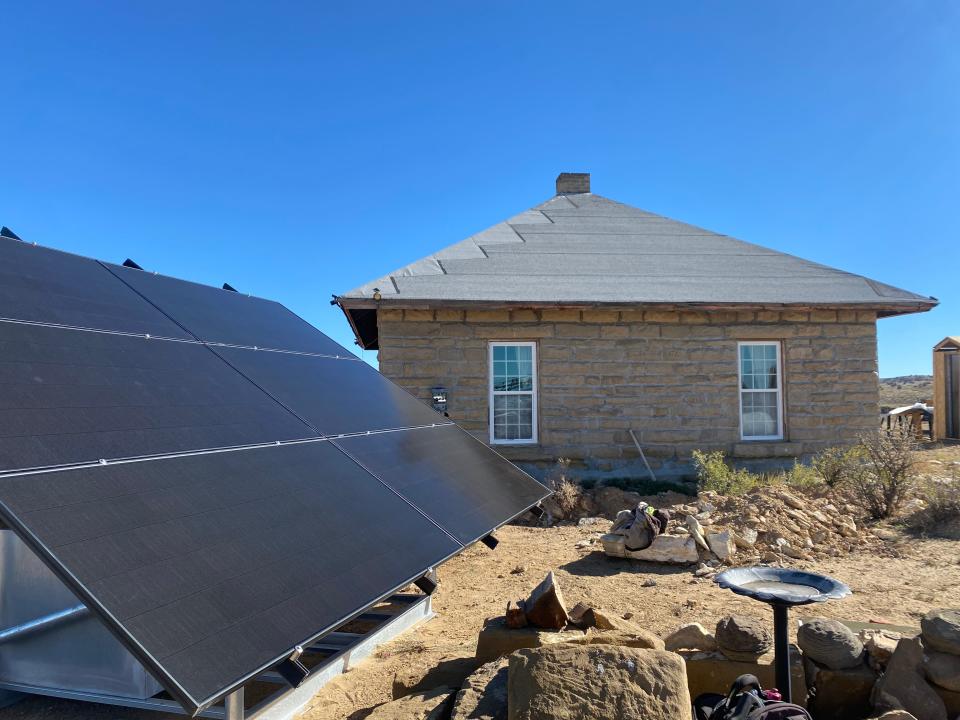NTEC gets $2.6 million federal grant to install solar panels on remote Navajo Nation homes
Dozens of homes on the Navajo Nation that don’t have electricity soon could be powered up, thanks to a Navajo Transitional Energy Company project that has gotten a boost from the federal government.
NTEC officials announced in a Sept. 12 news release that it had received a $2.6 million grant from the U.S. Department of Energy’s Office of Clean Energy Demonstrations to accelerate the company’s Light Up Navajo! Home Solar Installation program. The grant will allow the company to install solar energy systems on several homes throughout the Navajo Nation that are still several years from being reached by the traditional electrical grid.
Andy Hawkins, the senior manager for community relations for NTEC, said the company already had launched the pilot project before it received the DOE grant, having installed 18 systems on Navajo Nation homes — 15 of them in New Mexico — over the last couple of years. In the years ahead, another 125 systems will be installed, with the federal grant covering the cost of 75 of them and NTEC footing the bill for the other 50 at a cost of $1.3 million, the release states.
More: Navy christens first-in-class support vessel at Louisiana shipyard
The systems will be installed across each of the Navajo Nation’s five agencies, with each agency receiving 25 installations, according to the release.
Hawkins said the systems will be installed in homes that are three to five years away from being in a position where they could be connected to the traditional power grid.

“These are truly remote locations,” he said.
As an example, Hawkins said one home that is among the 18 to already receive a system is 7 miles from the nearest power line.
“So it was going to be a long time, if ever, if that family was going to get put on the grid,” he said. “But if you’re a quarter of a mile away (from a power line) or two years away, you’re not what we’re looking for.”
Yolanda Benally-Littletree, the project lead for NTEC, said the goal of the project is to reach families on the reservation that have been left behind by the current energy economy.
More: Group files ethics complaint against Interior Secretary Haaland for Chaco moratorium
“The installation of these home solar systems will open even more doors to other programs that bring additional improvements,” she stated in the news release. “We are proud to partner with OCED to move this project forward and assist 125 families in increasing their standard of living.”
There will not be an application process for the solar systems, Hawkins said. Instead, NTEC officials will reach out to officials at the chapter houses on each agency and seek guidance from them about home that meet their target demographic.
More: Navajo Nation Gaming Enterprises CEO steps down, interim replacement named
It’s also likely NTEC officials will try to choose homes that are clustered relatively closely together to avoid lengthy travel times between work sites for NTEC employees, he said. Hawkins said the systems can be installed in only two or three days.
“It is very quick,” he said. “That’s why we like to cluster them together, rather than having our crews drive a long way between jobs. We can actually do four in a week if we cluster them close enough together.”
Hawkins said the systems cost $25,000 in equipment and labor for each home, although there can be extra expenses for digging trenches and hiring licensed, bonded electricians to update the electrical boxes that already may exist on a home, if they have been serviced by a generator or previous solar system.
More: Supreme Court rejects Navajo Nation's water rights trust claim
NTEC’s receipt of the DOE funding — which is supposed to arrive in the spring of 2024 — is the first time the company has sought outside funding for the Light Up Navajo! project, he said. Hawkins said the company likely would be open to the possibility of seeking additional grants in the future to continue the work.
After installing the systems, NTEC workers walk the homeowners through the specifics of how to manage the system, even teaching them how to create an “electrical budget” — a priority list for appliances or equipment that are more important than others.
Hawkins said that while solar systems have come a long way in recent years, they do not offer an unlimited supply of energy, and users have to learn there will be times when they can’t keep everything operating.
“If you have two or three cloudy days in a row, the system doesn’t run 100%,” he said.
NTEC workers conduct follow-up visits a year after the installation to trouble-shoot problems for homeowners and respond to additional questions, he said.
More: Four Corners filmmaker to release latest project 'Touch the Water' in November
“That first day (when the system is operating), you don’t know what to ask,” he said, noting that the follow-up visits are about teaching users how to employ their systems more efficiently.
Hawkins said he had visited with one or two of the families who already have received a system and said they were very grateful.
“It’s brought a big improvement to their standard of living,” he said. “They’re able to do things they weren’t able to do before, like run a refrigerator or run their lights at night, which is a big deal if they have kids who need to do their homework. … It’s been overwhelmingly positive.”
Mike Easterling can be reached at 505-564-4610 or measterling@daily-times.com. Support local journalism with a digital subscription: http://bit.ly/2I6TU0e.
This article originally appeared on Farmington Daily Times: Project calls for installing solar systems on 125 Navajo Nation homes

